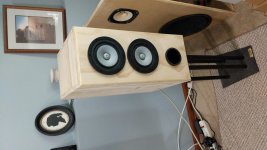Any ideas after all this time ?
Boxes done and up and running. Test boxes only. Sound far exceeded my expectations. Push pull 6B4G amp, passive transformer pre, older Opus 4 with P3A DAC.
Nope top wide open and bottom with a 3mH inductor in series. Drivers are in parallel.
What frequency does does that cut off?
Nope top wide open and bottom with a 3mH inductor in series. Drivers are in parallel.
May I ask why you used 2 Alpair 10P's per enclosure?
I'm asking because I'm also curious as I've also been wanting to do something like that confguration, but I am not sure of any drawbacks of that particular config
It depends how you wire the 2 drivers together.
In parallel, one gets a 6dB sensitivity increase (3dB efficiency increase), at the expense of some high frequency combing which you may or may not have an issue with.
If you want to use only one driver at HF then either wire in parallel with inductor in series with one driver or wire inseries and shunt one driver with a big cap. The former gives 6dB more level below the inductor or in the latter one gets the same sensitivity of 1 driver across the band, but below the cap you have 2 drivers moving air, not just one. This last is the one i like.
http://www.planet10-hifi.com/downloads/Dual-Driver-Wiring.pdf
dave
In parallel, one gets a 6dB sensitivity increase (3dB efficiency increase), at the expense of some high frequency combing which you may or may not have an issue with.
If you want to use only one driver at HF then either wire in parallel with inductor in series with one driver or wire inseries and shunt one driver with a big cap. The former gives 6dB more level below the inductor or in the latter one gets the same sensitivity of 1 driver across the band, but below the cap you have 2 drivers moving air, not just one. This last is the one i like.
http://www.planet10-hifi.com/downloads/Dual-Driver-Wiring.pdf
dave
How about when put in series, without any filters (both run fullrange)?
What are the advantages/disadvantages?
What are the advantages/disadvantages?
Depends i guess on the amp.
Same issues as in parallel, but no gain in sensitivity (+3dB efficiency)
dave
Same issues as in parallel, but no gain in sensitivity (+3dB efficiency)
dave
I think that A little of the pdf is wrong.
I swear I read a jbl pdf saying when you double the drivers, you halve the excursion, thusly lowering the harmonic distortion to a quarter......
I swear I read a jbl pdf saying when you double the drivers, you halve the excursion, thusly lowering the harmonic distortion to a quarter......
That sounds like it could well be correct. I don’t pay much attention to HD, but there is a 4x factor with excursion with each octave lower.
dave
dave
What about using one amplifier for each driver ?
What's the value for the cap ? Tks
It depends how you wire the 2 drivers together.
...or wire ins eries and shunt one driver with a big cap.
What's the value for the cap ? Tks
Last edited by a moderator:
Thanks for the replies.
Yes that was what I was also thinking regarding multiple same drivers
For possible lobing or phase issues, I don't know.
Yes that was what I was also thinking regarding multiple same drivers
For possible lobing or phase issues, I don't know.
What's the value for the cap ? Tks
Depends on where you want to cross.
It is not overly critical since the sensitivity should not change.
First you want to be at least big enuff to be below the quarter-wavelength of the 2 drivers centre-to-centre. At the other end it is more open ended but i like it to be somewhere around the baffle step.
The higher you cross the louder you should be able to play.
For a 1st pass i’d use the text-book XO for the quarter-wavelength and then bump it up to the next convenient size.
I wouldn’t use anything less than one of the cheap Solen polys.
dave
- Home
- Loudspeakers
- Full Range
- Alpair 10p Build
